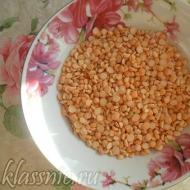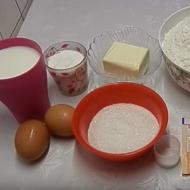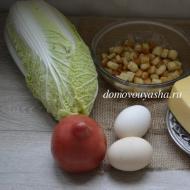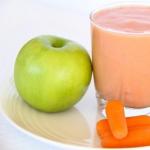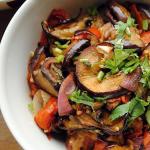
Vegetable diets: benefits and harms. The benefits of fruits and vegetables. The healthiest vegetables and fruits Stewed and boiled
As a rule, all vegetables are healthy, but some of them, in addition to vitamins and minerals, also contain other valuable compounds or have particularly beneficial properties. Here are the 10 healthiest vegetables that are really worth including on your menu.
The inside of a sweet potato can range in color from yellow to bright orange. This color indicates the richness of carotenoids (especially beta-carotene or ). These substances are powerful antioxidants that protect our body from free radicals and take care of the good condition of our skin and vision. Sweet potatoes should also be included in the diet due to the content of B vitamins and magnesium, a friend of the immune system - vitamin C, as well as manganese, potassium and phosphorus, which take care of the proper functioning of the nervous system.

Sweet potatoes are a healthy vegetable that will be very important in the diet of diabetics. First of all, the vegetable contains fewer calories and lower carbohydrate content than traditional potatoes, and a little more fiber, which regulates the digestive system. At the same time, research has shown that extract obtained from various varieties of sweet potatoes helps control blood sugar levels in people with type 2 diabetes. Therefore, research has confirmed recommendations that describe sweet potatoes as a natural health support for diabetes, It’s not for nothing that it is included in the ranking of the healthiest vegetables.
Attention! People suffering from it should not eat sweet potatoes. It, like rhubarb, sorrel or spinach, contains oxalates, which contribute to the formation of deposits (so-called kidney stones).
No. 9. Garlic is a friend of immunity, heart and beauty
Garlic is an excellent natural immunity booster and a very healthy vegetable. These properties are due to the content of allicin, which has bactericidal and antifungal activity. Researchers report that, thanks to allicin, garlic extract can fight certain microorganisms and viruses (including, for example, Helicobacter pylori).
Allicin is considered primarily as a substance that supports the functioning of the cardiovascular system and reduces cholesterol levels in the blood.
Like pumpkin seeds, garlic is a vegetable that has been considered an aphrodisiac for centuries. It also contains sulfur compounds that have a positive effect on beauty, including the condition of hair and nails. It is recommended for women suffering from menstrual disorders, such as painful cramps. It’s not for nothing that garlic is included in the list of the healthiest vegetables.
But be careful - eating garlic in excess can cause bloating and abdominal pain, especially in people with sensitive guts.
No. 8. Beets - for heartburn and hypertension
This healthy vegetable contains red-violet dyes, which also act as antioxidants. Betaine is very important here, which in addition to protecting the body from free radicals has antibacterial activity. For this reason, it is better to choose the darkest vegetables to eat - those with the highest pigment content.
Benefits of consuming beets include the ability to lower high blood pressure and improve cardiovascular health. It is believed that this may be due to the effect of nitrates contained in these vegetables.

Beets, if consumed regularly, should help if you often suffer from heartburn and improve the functioning of the digestive system.
Have you heard that beets help with anemia? This is due to the content of folic acid, namely vitamin C. Both of them are important for the hematopoietic system - and their deficiency can cause anemia.
Of course, beets are one of the healthiest vegetables.
Attention - beets contain a lot of sugars, which can cause excessive fermentation in the intestines. Therefore, if you experience flatulence and/or diarrhea after drinking beets or juice, it is better to avoid it. Especially if you suffer from inflammatory bowel disease.
No. 7. Tomatoes - contain lycopene
Although tomatoes are more associated with Mediterranean cuisine, they are the most consumed vegetable in our country and can safely be called a very healthy vegetable.
Tomatoes also contain lipoic acid, which supports metabolism, improves metabolism and regulates blood sugar levels. Tomatoes contain choline - recently considered a vitamin (B4), which supports memory, has a beneficial effect on the functioning of the nervous system, muscle contraction and ensures a good night's sleep. Due to their potassium and fiber content, tomatoes are recommended in the diet of people susceptible to developing cardiovascular diseases.
Tomato should not be combined with green cucumber. Fresh cucumber, like zucchini, contains an ascorbate enzyme that breaks down vitamin C.
No. 6. Peppers - color matters
Pepper is a close relative of tomatoes, which has a huge list of beneficial properties. Various peppers are one of the healthiest vegetables. Albert Szent-Gyorgyi, who was awarded the Nobel Prize for the discovery and determination of the chemical structure of vitamin C, isolated it from peppers. Already 100 grams of red or green pepper will provide us with more than a daily dose of this valuable antioxidant. Slightly less of this ingredient can be found in orange and yellow peppers. In terms of vitamin C content, pepper is even ahead of lemon.
Pepper is also an excellent source of carotenoids, beta-carotene and lutein, which take care of our vision. Peppers are rich, especially in rutin, which seals blood vessels and protects vitamin C from oxidation, enhancing its effect. Capsaicin is an alkaloid similar to the pungent taste of paprika, which naturally warms and supports metabolism. However, look for it in hot-flavored pepper varieties.
Remember - hot peppers should not be included in the diet of young children, the elderly and people suffering from certain diseases of the digestive system.
No. 5. Pumpkin - for beauty and fertility
Pumpkin has always been considered a very healthy vegetable. Pumpkin pulp is a good source of carotenoids, largely beta-carotene - provitamin A. It contains vitamin C, magnesium, potassium, phosphorus and. Pumpkin improves the functioning of the digestive system and, in particular, the intestines.
Pumpkin seeds should not be thrown away; they also have beneficial properties. The Indians believed that they were not only an aphrodisiac, but also an excellent means of maintaining fertility. As it turned out, they were not mistaken. They contain a lot of zinc, and it takes care of both our appearance (primarily the condition of the skin) and the life expectancy of sperm. Another treasure of pumpkin seeds, selenium, has its share in the production of male sperm. In our country, crushed fresh pumpkin seeds have been used for years as a natural deworming remedy, especially against pinworms.
This compound is a common component of dietary supplements for men suffering from benign prostatic hypertrophy.
Pumpkin improves the functioning of the cardiovascular system.
Pumpkin seed oil is a good source of cucurbitacin. It also contains omega-6 fatty acids, especially linoleic acid, which is essential for regulating blood cholesterol levels. Pumpkin oil is also rich in vitamin E, zinc and beta-sestrinol - it will take care of proper hydration of our skin and help maintain its elasticity. In a word
No. 4. Artichokes are not just for diabetics
Artichokes are very healthy and have unique nutritional value. They contain 20% of your daily dose of folic acid, vitamin K and C and sodium, magnesium, manganese and potassium, and smaller doses of other vitamins and minerals.
Their advantage is primarily the high content of antioxidants - compounds that slow down the aging process, protecting the body's cells from the effects of free radicals. Artichokes are one of the leaders in antioxidants among vegetables. Interestingly, under the influence of heat treatment, the content of antioxidants not only does not decrease, but even increases.

Cynarine is a compound that helps protect and repair the liver, while at the same time supporting body cleansing and digestive processes. Artichokes are rightfully included in the TOP healthy vegetables.
No. 3. Spinach - rich in folic acid
Spinach is considered by many to be a very healthy vegetable. Indeed, spinach is a valuable addition to the diet. It contains a lot of vitamin K, carotenoids, beta-carotene, lutein and zeaxanthin and vitamin C. Spinach is useful due to its high content of folic acid (or vitamin B9). It is involved in the synthesis of two important neurotransmitters: serotonin and norepinephrine. Two more elements found in spinach are very valuable for the nervous system - manganese and magnesium.
Eating spinach improves brain function and calms the nervous system.
No. 2. Cabbage
Cabbage, which was a thing of the past for a while, is making a comeback today. She can safely stand on a par even with her relative - broccoli. Despite its availability and low price, cabbage is one of the healthiest vegetables.
Like broccoli, cabbage is high in vitamins K and C, as well as sulforaphane. Cabbage leaves contain a large dose of calcium, which enriches it with beneficial properties. Cabbage is a good source of carotenoids, which care for both the appearance of our skin and good vision.
Remember that cabbage, like broccoli, should not be too common in the diet of people with hypothyroidism. It should not be consumed in excess by people suffering from kidney stones. Like sorrel or rhubarb, cabbage contains oxalates - compounds that affect the formation of calcium oxalate deposits (aka "calcium stones").
No. 1. Broccoli and cauliflower
Broccoli is a very healthy vegetable and the leader in our rating. You'll likely find broccoli in most healthiest vegetable rankings.
Broccoli is valued mainly for its high content of vitamins C and K. The first of them is one of the strong antioxidants, supports the cleansing of the body, protects against free radicals and at the same time takes care of the good condition of the skin and tendons, cartilage and bones. The second one stimulates the proper functioning of the cardiovascular system, takes care of the correct course of the blood clotting process. One serving of broccoli (about 100 g) is enough to provide us with a full daily dose of both of these vitamins.

Broccoli is also one of the richest sources of sulforaphane. According to available data, this substance has antitumor activity, as well as antibacterial (including against Helicobacter pylori) and anti-inflammatory. This vegetable has a positive effect on the functioning of the digestive system as a whole.
Although broccoli is generally healthy, the vegetable should not be consumed in excess by people suffering from hypothyroidism. Like other plants in the cabbage family, they contain goitrogens - substances that interfere with the absorption of iodine.
Cauliflower has a positive effect on the functioning of the cardiovascular system, removes cholesterol from the body, and helps strengthen the walls of blood vessels.
Try to eat as many healthy vegetables from our rating as possible, this will bring health benefits, slow down aging and prolong life.
When they talk about healthy food, the first thing they mention is our guests today – vegetables. But are they really that useful? Can vegetables be harmful? Let's figure out together what are the benefits of vegetables and what are their disadvantages.
The benefits of vegetables for humans
Undoubtedly, it is impossible to imagine a person’s diet without vegetables – at least if he expects to live at least a relatively long time. Their benefits to the body and role in digestion and metabolic processes are very high.
For example, most vegetables are high in fiber. Thanks to this, they are a very effective irritant for our intestines, which significantly improves peristalsis. What does this mean? Food does not stagnate inside the body, but is systematically released naturally. The digestive system does not experience unnecessary stress, your health improves, as does your well-being thanks to the lightness in your body.
Also, all vegetables contain a significant amount of various vitamins that are beneficial to the human body, which help our immunity. A significant amount of minerals, pectin, organic acids contained in tomatoes, cucumbers and other vegetables will also be more than useful to you.
Of course, it’s not worth eating vegetables alone in the long term, since they do not contain the full range of vitamins a person needs. But they are perfect as a side dish for popular foods such as meat, fish, and various grains. The big advantage of vegetables is that they help in the digestion of all foods that accompany a meal, improving the absorption of nutrients from them.
The characteristics of vegetables depend, among other things, on the methods of their processing. The simplest is to eat vegetables without heat treatment in any way, that is, raw. Vegetables in this form retain their beneficial properties to the fullest.
If you resort to heat treatment, the amount of vitamins and other biologically useful substances in vegetables decreases, but at the same time their absorption by the digestive system is greatly simplified, that’s how it works. That is why most specialists and nutritionists recommend that raw and thermally processed vegetables alternate in your diet - in this case, you will absorb the full complex of vitamins. As for their quantity in the diet, you need to eat vegetables every day, at least 100-200 grams, thermally processed or not.
Thanks to the fact that modern agriculture, as well as supplies from abroad, allows us to eat vegetables all year round, we definitely need to take advantage of this. Fortunately, vegetables grown in greenhouses or brought from distant countries are no different in their beneficial properties from those grown in the fields using the usual method.
Many nutritionists recommend vegetables as the basis of a diet when losing weight. The reason is the amount of fiber in them. The fact is that due to the abundance of fiber, quite a lot of time, and at the same time energy, is spent on digesting and assimilating vegetables. But eating only vegetables, that is, a mono-diet, is quite dangerous - the body does not receive all the necessary substances, and over time begins to destroy its own proteins. Therefore, both professional nutritionists and we strongly recommend that you combine vegetables with other foods when on a weight loss diet, rather than chasing the fastest possible loss of extra pounds.
Having talked about the general beneficial properties of vegetables, let's figure out exactly what benefits some individual types of vegetables can bring.
What are the benefits of popular vegetables
Our list includes several of the most popular vegetables in our country, often found on Russian tables, both on their own and as part of various dishes. It is worth knowing about their properties in order to cook correctly, getting the maximum of vitamins and useful macroelements.
- Pumpkin. It is quite rarely eaten in its pure form today and many people have undeservedly forgotten pumpkin. But it is great for making delicious purees. And also sweet cereals. The beneficial properties of pumpkin match its taste: it contains a lot of vitamin D, which will help your children grow. It also contains alpha-linolenic acid, which helps our blood supply and strengthens the walls of blood vessels. Pumpkin is generally very beneficial for our cardiovascular system thanks to its dietary fiber and pectin, which not only neutralize excess cholesterol, but also remove it, preventing it from accumulating on the walls of blood vessels.
- Cabbage. The beneficial properties of cabbage have been known since ancient times. It contains a large amount of fiber. As we said above, fiber takes a long time to be absorbed by the human body. It is interesting that the beneficial characteristics of cabbage are manifested to a greater extent when it is fermented, since the amount of vitamin C in it increases significantly. Therefore, in the cold season, when we traditionally lack this vitamin, it is worth choosing sauerkraut in addition to your favorite meat, and not any other vegetables. In addition, it is useful for obese people - sauerkraut is quite low in calories.
- Potato. Despite their popularity in various forms, potatoes are far from the healthiest vegetable. The problem is that potatoes are quite complex for humans to digest. But it contains a lot of potassium that is beneficial for our heart and nervous system. The popularity of potatoes in Russia is difficult to overestimate; they are even called “second bread”. Typically, potatoes are used in the preparation of various dishes, including borscht, various soups, etc. Note. That the main difference between different varieties of potatoes is the level of starch content in them. If you are going to mash or bake potatoes, choose a vegetable with a high starch content. If you prepare salads or soups, use less starch. By the way, the most useful element is in the skin of the potato, so it is better to bake it whole and eat it straight with the skin. Then you will get the maximum possible benefit from this popular vegetable. But it’s still not worth eating a lot of it.
- Jerusalem artichoke. In our country, Jerusalem artichoke is not particularly popular, but in vain. After all, it contains a lot of inulin, which perfectly compensates for the lack of insulin. Thanks to this, Jerusalem artichoke is a very useful product for people with diabetes. It should be eaten raw, using it as an ingredient for various fresh salads.
- Black radish. An extremely healthy vegetable. Its juice is especially useful - mix it with honey and take it when you have a cold. Also, black radish contains a lot of potassium, calcium and magnesium. This root vegetable helps our immunity and normalizes blood sugar levels.
- Celery. Celery root helps cleanse the body, has a good effect on protein absorption and promotes normal functioning of the gastrointestinal tract. We recommend trying a salad consisting of raw celery, carrots, nuts and olive oil. You can also eat the juicy stems. Celery is interesting because it takes a long time to be digested by the body and a lot of energy is spent on it, which is a plus for losing weight. But remember that it also stimulates gas formation, just like cabbage, by the way, so don’t overuse it, especially before an important meeting.
- Parsley. Use parsley root in food with caution. Yes, it contains quite a lot of different substances and minerals that are useful for our body, which do a good job of stimulating the functioning of important organs, including the thyroid gland. But keep in mind that pregnant women should avoid parsley - it contains substances that can increase the tone of the uterus and thereby provoke a miscarriage.
The benefits of both these and many other vegetables can hardly be questioned. But is there any harm from vegetables? Let's look into this too.
Harm from vegetables
In addition to the harm from parsley that we have already mentioned, other vegetables can also be dangerous. We have selected several vegetables for you, the harm from which can sometimes outweigh the benefits.
- Zucchini. Normally quite useful, zucchini can cause serious harm to you and cause an acute attack if you have gastritis with high acidity, as well as digestive system problems such as peptic ulcers of the stomach and duodenum.
- Cucumbers. Although cucumbers are extremely popular, they should be excluded from your diet if you have an exacerbation of stomach ulcers, duodenal ulcers, as well as various acute gastritis and enterocolitis. The reason is that cucumbers, due to their composition, increase the acidity of gastric juice.
- Beet. If you have diabetes or urolithiasis with oxalate stones, then beets should also be excluded from your diet. The reason is the high level of sugar in the vegetable.
- Spinach. Although spinach is quite popular in weight loss diets, it can also be harmful due to the fact that it contributes to the formation of oxalates in the kidneys. It should not be used for nephritis, colitis and some other diseases.
In addition to the vegetables we have listed, many others can also be harmful for certain diseases. Therefore, you should definitely follow your doctor’s recommendations and the prescribed diet. In addition, a mono-diet for weight loss, as we said above, can also be harmful if it consists only of vegetables. We need balance in everything, and we certainly need it in our diet.
Conclusion
Vegetables - the basis of every person’s diet; in one form or another they are found in almost every dish we eat. But you should treat them with understanding and know that in addition to their undoubted benefits, they can also harm you if you have problems with the digestive system or simply if you consume them in excess.
Vegetables are an indispensable product in the diet of any person. They are valued for their excellent taste and nutritional characteristics, and their therapeutic and prophylactic effects on the body. The beneficial properties of the fruits have found their application in cooking and the food industry, in medicine and cosmetology. The benefits and harms of vegetables, however, depend on the individual cases of their consumption.
What are the benefits of vegetables?
The benefits of vegetables for the human body are enormous: they play a decisive role in maintaining human health and vital activity. The beneficial properties of a vegetable diet are manifested in the treatment and prevention of many diseases, neutralizing harm from taking medications, fatty and high-calorie foods, and much more.
Nervous system
Energy
Vegetables are digested well and quickly without high energy costs. The fruits contain excess water; they can simultaneously quench both hunger and thirst. If you eat vegetables for breakfast, the benefits will be expressed in a boost of energy for the whole day.
Attention! In the morning it is good to drink freshly squeezed juice or eat porridge with a vegetable side dish.
Source of vitamins
The medicinal properties of vegetables are explained by a large set of vital chemical elements. Biologically active compounds are fully absorbed, unlike synthetic analogues. Therefore, no pharmaceutical preparations can replace plant foods. In addition, synthetic vitamin and mineral complexes can cause harm to the body and worsen health.
Weight loss
Plants contain large amounts of fiber. Its benefit lies in its influence on the formation of the internal environment of the intestine, while it is not absorbed and has no energy value. Dietary fiber swells in the stomach and creates a feeling of fullness for a long time, which does not give rise to overeating. Fiber cleanses the body:
- from cholesterol;
- slags;
- toxins;
- carcinogens.
Due to their low calorie content, vegetables can be eaten in any quantity as desired, and this will in no way affect your figure.
Attention! Most vegetables speed up metabolism, helping the body get rid of excess fat.
Rejuvenation
Antioxidants are useful chemical compounds whose properties help cells recover and renew and prevent the damaging effects of free radicals on them. The role of antioxidants is played by flavonoids, anthocyanins, tannins, some trace elements (for example, selenium), nicotinic acid, and others.
Mental activity
The beneficial elements contained in plant products help keep blood vessels clean, making them elastic and not susceptible to harm and the destructive influence of external factors. This helps to keep your mind clear until old age, your memory sharp, and also to avoid such serious diseases as atherosclerosis, thrombosis, and others.
Immunity
The medicinal properties of vegetables and their rich nutritional composition help strengthen the body's defenses and resist diseases, including such complex ones as cancer and diabetes. First of all, fruits of bright, saturated colors are used for this purpose. Research has proven that they have more beneficial properties necessary to increase the body's protective barrier. , contained in greens, also affects special cells of the immune system related to the first line of defense (intraepithelial lymphocytes).
Attention! To strengthen your immune system, you need to eat more fresh vegetables and herbs.

What vegetables are the healthiest?
The choice of vegetables is quite rich. Therefore, it is important to know about their properties and, based on this, create your diet. List of the most useful:
- Tomatoes: rich in the antioxidant lycopene, which provides a therapeutic and prophylactic effect against cancer, vascular inflammation, atherosclerosis, and other pathologies. They contain the most vitamin A, which provides protection against free radicals - the main factor of harm in the development of cancer;
- Broccoli: contains the substance sulforaphane, which can kill Helicobacter pylori, thereby protecting the stomach from ulcers and gastritis, as well as counteracting the development of cancer cells. The vegetable is rich in nutrients that strengthen the immune system (carotenoids, ascorbic acid, folates);
- Brussels sprouts: contains a high concentration of folic acid, which is especially useful for pregnant women, as well as B vitamins. Omega-3 properties help rejuvenate the skin and improve brain function;
- Carrots: are a source of antioxidants, as well as vitamin A, the beneficial properties of which help improve appearance and vision;
- Pumpkin: contains significant amounts of magnesium, potassium, and is therefore essential for the heart. The high fiber content helps remove cholesterol, which serves as a good prevention of atherosclerosis. The vegetable improves skin condition, slows down the graying of hair, and is also good for vision and liver diseases;
- Sweet potato, or sweet potato: it contains iron, vitamins A, C, which makes the fruit an important component of the vegetarian menu;
- Eggplant: removes cholesterol, excess fluid, and due to its high potassium content, fiber ensures proper functioning of the heart;
- Sweet bell pepper: it contains the most ascorbic and folic acids, antioxidants, and other elements. Red varieties are healthier: their composition protects the body from diabetes, lycopene – from cancer, and dietary fiber – from atherosclerosis;
- Spinach: has almost all the essential nutrients. Has a good effect on the functioning of the gastrointestinal tract, salivary and pancreas, strengthens visual function;
- Onion: useful for osteoporosis, improves calcium absorption. It has a therapeutic and prophylactic effect for diabetes and vascular pathologies.
Other vegetables also have an impressive supply of beneficial properties. Each of them contributes to the healing of the human body.
How many vegetables can you eat per day
Scientists advise introducing as many vegetables and fruits into your diet as possible. They even give exact numbers: 5 servings of 80 g each during the day. In the fast pace of modern life, it is unlikely that you will be able to follow such a pattern exactly. But still, the diet should consist of more than half of vegetables, herbs, and fruits.
Attention! Vegetables will bring maximum benefit in their raw form. But the consumption of some of them, for example, eggplant, is contraindicated without heat treatment.

What vegetables can you eat when losing weight?
Vegetables are an indispensable aid to those who want to lose weight. They are generally low in calories, contain plenty of fiber, and are loaded with healthy nutrients. Those who are losing weight need to eat the following foods:
- Eggplant: one of the lowest calorie vegetables (24 kcal), while causing a lasting feeling of fullness. Its harm is manifested in its ability to quickly absorb fat, so it cannot be fried;
- White cabbage: contains elements that accelerate the breakdown of fats. All types of cabbage have beneficial properties for weight loss;
- Leafy greens: contain chlorophyll, which suppresses appetite;
- Cucumbers: contain a large percentage of water, have low calorie content, and a diuretic effect;
- Tomatoes: help to better absorb food, reduce the load on the gastrointestinal tract;
- Pepper: contains phytosterols that regulate fat metabolism;
- Beans: a source of protein that can replace meat and also promotes fluid removal.
Any vegetable dishes prepared in a gentle way and without adding fat are indicated during weight loss. Such food will give you a feeling of satiety, saturate you with beneficial properties, and neutralize harm from eating low-quality products and from the consequences of environmental exposure.

How to eat vegetables correctly
The benefits of fresh vegetables eaten raw are well known. In this form, all biologically active compounds are preserved, which not only provide nutrition to the cells and tissues of the body, but also act on it like effective medicines. For therapeutic and prophylactic purposes, it is better to eat raw foods on an empty stomach, 0.5 - 1 hour before meals: during this time, the beneficial elements will be absorbed and show their healing properties.
However, not everyone and not always can eat raw food: they can be harmful to children and patients with chronic gastrointestinal pathologies. However, heat treatment should be as gentle as possible, no more than that which preserves the benefits of boiled vegetables. Valuable nutritional elements begin to be destroyed even at relatively low heating - +40 o C, and during high-temperature processing only a small part of them remains in the food.
In what form are vegetables healthier?
Most products of plant origin retain and transmit their beneficial properties in their raw form. Some chemical compounds begin to break down already at +50 o C. Therefore, to preserve them, very gentle cooking must be used. If it is not possible to do without heat treatment, the method of steaming vegetables will be beneficial.
Attention! Raw plant foods are not always healthier, and sometimes they can be harmful to a person.
For example, several times more carotenoids and antioxidants are absorbed from it. Raw foods can be dangerous for children. Fiber has a detrimental effect on the fragile pancreas.

Stewed and boiled
The benefits and harms of stewed vegetables are somewhat different from thermally unprocessed foods. Raw plant foods contain more vitamins, but from boiled and stewed dishes the remaining substances are better and more fully absorbed. For example, tomatoes that have been exposed to temperature are healthier than their raw counterparts. Heat treatment increases the benefits of stewed vegetables by improving the absorption of lycopenes and red pigments - powerful antioxidants that neutralize damage from free radicals.
Baked
It is better to bake eggplants or zucchini in the oven. The concentration of potassium in them will increase, and nitrites and other harm will go away along with the liquid flowing into the pan. Baked potatoes also maximize their beneficial properties.
The benefits of roasted vegetables are significant. Supporters often accumulate excess strontium in their bodies. And this is fraught with the displacement of calcium and magnesium. As a result, the risk of harm from developing osteoporosis increases. Eating baked vegetables can solve this problem.
Dried
Attention! Dried vegetables can be used after soaking or without it. They are great for cooking.

How to properly store vegetables
There is no one same rule for all vegetables. Each product requires its own individual approach. Cool, dark places are generally suitable for storing vegetables:
- fridge;
- cellar;
- pantry;
- garage;
- basement.
Vegetables can also be frozen or canned, thereby preserving their beneficial properties for a long time.
Are vegetables harmful?
Vegetables can be harmful if you do not take into account the individual characteristics of the person consuming them. For example, such a healthy vegetable is contraindicated in case of increased gastric secretion, since it has the property of stimulating the secretion of digestive juices. It should not be used for pancreatitis.
When growing vegetables, various chemical fertilizers are used, which from the soil enter the plant cells and then harm human health. The surface can be treated for better preservation during long-term transportation.

Conclusion
Understanding the benefits and harms of vegetables is necessary when creating a daily diet. When used correctly, taking into account individual contraindications, they serve as an indispensable source of vital substances for a person.
Did you find this article useful?
Can a person do without meat, fish, bread and dairy products? Maybe. But without vegetables, proper nutrition is impossible. You just need to eat them all year round, then your body will be healthy.
The benefits of vegetables for the body
Vegetables are an irritant; due to their high fiber content, they increase intestinal motility several times. Food does not stagnate, digestive processes occur evenly and quickly. This is normal digestion, which leads to excellent health.
Methods for processing vegetables are varied. There are adherents of a raw food diet, when fruits are consumed without any heat treatment. During heat treatment, the biological value of vegetables decreases, but microelements and vitamins are better absorbed from them. Therefore, it is best to alternate fresh and cooked vegetables. They should be present in the diet daily, at least in small quantities and in any form.
You need to eat vegetables all year round, fortunately these days this is not a problem. Now in all major cities there are greenhouses in which tomatoes, cucumbers, and almost all other vegetables are grown even in winter. There are also those that come from warm countries, and many root vegetables are well stored from autumn to spring in the cellar or basement.
In the gastrointestinal tract, vegetables are digested for quite a long time, and a large amount of energy is spent on the absorption of fiber. That is why they are recommended for different diets. The main thing to remember here is the following rule: vegetables should not be washed down with anything (even plain water), so as not to provoke fermentation processes. Mono-diets based on vegetables can be dangerous. Of course, a person loses weight on such a diet, but gradually it is not fats that begin to be destroyed, but the proteins of his own body. They are quite difficult to restore, especially in old age. Many nutritionists have come to the conclusion that eating only vegetables is wrong.
What are the benefits of individual vegetables?
- Pumpkin is great for making purees and sweet cereals. It has many beneficial properties: vitamin D helps children grow, alpha-linolenic acid stimulates blood circulation and strengthens the walls of blood vessels, dietary fiber and pectin neutralize and remove excess cholesterol.
- Cabbage is also a healthy vegetable. It contains a lot of solid fiber, which takes a long time to be absorbed by the body. When cabbage is fermented, its beneficial properties increase and the amount of vitamin C increases, so in winter it is best to use sauerkraut as a side dish for meat. Experts recommend this product for obese people due to its low calorie content.
- Potatoes are a less healthy vegetable. This is a difficult product to digest, but it contains a lot of potassium, which is necessary for the normal functioning of the heart and the conduction of nerve impulses. It is so popular in our country that it is called “second bread”. You can’t make soup or borscht without potatoes; various salads are made with it; this vegetable is also good as a side dish. Potato varieties may differ in starch content. For cooking purees and baking in the oven, you need varieties with a high starch content, and for soups and salads, those with less starch are better suited. The most beneficial substances in potatoes are found in their skins, so it makes sense to bake them whole and eat them with the skins. This way all microelements and vitamins can enter the body. Potatoes should be stored and sold unwashed so that they last longer and do not turn green, because green potatoes contain the poison solanine (its entry into the body leads to poisoning).
- Jerusalem artichoke is recommended for patients with diabetes. It contains the substance inulin, which replenishes the lack of insulin. Jerusalem artichoke is eaten raw and added to salads.
- Black radish is a root vegetable, the juice of which, combined with honey, helps with colds. In addition, radish is rich in potassium, calcium, magnesium, it is an immunostimulant, cleanses the intestines of toxins, and normalizes blood sugar levels.
- Celery root is also useful - it expels toxins, helps with protein absorption, and stimulates the gastrointestinal tract. A salad made from raw celery, carrots, nuts and olive oil is considered very healthy. The succulent stems of this plant are also used for food. Celery takes a long time to be absorbed by the body, a lot of energy is spent on its digestion (good for weight loss), and it also increases gas formation, like cabbage.
- Parsley root also contains many beneficial substances and minerals; it stimulates the functioning of such an important organ as the thyroid gland. True, parsley root contains certain substances that increase the tone of the uterus, which can provoke a miscarriage. Pregnant women should avoid using this product.
The benefits of vegetables are undeniable. They should be the basis of a person’s diet and, at least in small doses, be present on the table every day in any form and in different dishes. Eat more vegetables and you will be healthy!
Vegetables and their leaves contain a large amount of biologically active substances that are valuable for the normal functioning of the body.
 Eggplant– an annual plant, fruits of purple color of varying intensity, cylindrical, spherical or pear-shaped.
Eggplant– an annual plant, fruits of purple color of varying intensity, cylindrical, spherical or pear-shaped.
Eggplants are harvested as they ripen. Freezing makes them unsuitable for consumption. Fruits must be collected during the period of technical maturity. During the period of biological maturity, fruits and seeds become coarse and unsuitable for nutrition.
Eggplants are healthy for atherosclerosis and liver diseases, since they enhance the removal of cholesterol from the body, reduce its concentration in the blood and on the walls of blood vessels, as well as for gout and uric acid diathesis, since they increase the secretion of uric acid by the kidneys. The increased potassium content in fruits improves heart function and increases urination during edema of cardiac origin.
Eggplant fruits are baked, salted, pickled, fried. They are used to make caviar and sauces for meat dishes.
 is a biennial plant that grows in areas with humid and temperate climates. Root vegetables and sometimes leaves are used for nutrition.
is a biennial plant that grows in areas with humid and temperate climates. Root vegetables and sometimes leaves are used for nutrition.
Root vegetables are recommended for normalizing motor function and bowel movements, but are contraindicated in acute diseases of the gastrointestinal tract. They have a diuretic and expectorant effect. The juice is used to treat hard-to-heal burn wounds.
Rutabaga leaves have a viscous and pungent taste, boiled - they give a pleasant decoction and soft greens, quite suitable for food.
Rutabaga is used in human and animal nutrition. C is retained in rutabaga even during long-term storage.
 - an annual plant that grows in the southern regions of the country. The annual consumption rate is at least 0.5 kg. Young fruits of a long cylindrical shape, white or yellow, are used for food. Standard zucchini should be young, fresh, clean, with not rough skin. At a temperature of 0° and relative humidity of 85-90° they can be stored for 10-12 days, maintaining appearance and taste.
- an annual plant that grows in the southern regions of the country. The annual consumption rate is at least 0.5 kg. Young fruits of a long cylindrical shape, white or yellow, are used for food. Standard zucchini should be young, fresh, clean, with not rough skin. At a temperature of 0° and relative humidity of 85-90° they can be stored for 10-12 days, maintaining appearance and taste.
Zucchini leaves can be used raw in salads and vinaigrettes. Boiled leaves (young) are tasty, and the decoction has a pleasant smell. Both the leaves and the decoction are used to season borscht, soups, and green cabbage soup. Caviar is prepared from zucchini, stuffed with vegetables, meat, and cereals. They have a weak diuretic effect, normalize intestinal motility, and are useful for edema of cardiac origin and constipation.
 - biennial herbaceous plant. Grows in the southern, middle and northern regions. The annual consumption rate of fresh cabbage in the middle and northern regions per person is 24 kg. Taking into account the different ripening periods and the high lightness of cabbage, its sale can be ensured throughout the year.
- biennial herbaceous plant. Grows in the southern, middle and northern regions. The annual consumption rate of fresh cabbage in the middle and northern regions per person is 24 kg. Taking into account the different ripening periods and the high lightness of cabbage, its sale can be ensured throughout the year.
A head of cabbage containsup to 90% water, proteins (1.8%), carbohydrates (5.4%), amino acids. Cabbage contains vitamins C, P, B1, B2, PP, B3, folic acid, carotene, provitamin D, biotin, vitamins K, E, and choline. The vitamin C content in the outer leaves of the head of cabbage is 2 times higher than in the inner leaves. After long-term storage, the amount of vitamin C decreases.
A head of white cabbage used in food must be fresh, clean, undamaged, and not loose.
White cabbage widely used for the prevention and treatment of a number of diseases. Taking into account the high content of ascorbigen in cabbage - the most stable form of vitamin C, it can be used, especially in winter, for the prevention and treatment of hypovitaminosis C. Vitamin U, contained in the juice of raw cabbage, helps eliminate the ulcerative process. It has been established that vitamin U also has an antisclerotic effect.
Raw and sauerkraut increases appetite, gastric secretory function, improves intestinal activity during constipation, and has a diuretic effect. Raw cabbage juice with sugar has an expectorant effect and reduces soreness in the chest. In ancient Rome, cabbage was recommended for insomnia, headaches, and to increase the body's resistance to various diseases.
Cabbage juice, diluted with water, it is useful to gargle during inflammatory processes. A gruel made from cabbage leaves with cheese and egg whites promotes rapid healing of burns, purulent wounds, and ulcers.
White cabbage is a valuable food product.
In addition to heads of cabbage, you can also use the upper leaves that do not cover the head of cabbage, and stalks.



